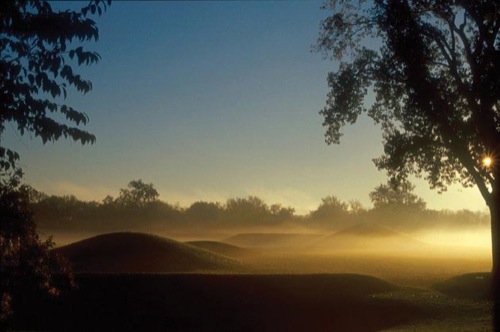
Hopewell Culture National Historical Park, courtesy NPS
Hopewell Culture National Historical Park
Chillicothe, Ohio
Hopewell Culture National Historical Park is centrally located among a host of special places related to Native American heritage all across central Ohio. The park offers groups the chance to explore these UNESCO World Heritage Site-nominated grounds over just a few hours or over several days.
The park is home to a series of monumental mounds and earthworks built more than 2,000 years ago by the Hopewell Native Americans that display the tribe’s deep understanding of geometry, architecture and astronomy, as their works align fluidly with the movements of the sun and moon. The Hopewell people invested an unfathomable amount of labor to build those sacred places, gathering raw materials from distant lands like the Great Lakes and the Appalachian Mountains, and assembled there for feasts, funerals and rites of passage.
“The park is a great place to take a quiet walk, and the ancient monuments never fail to evoke a sense of mystery and wonder about the native peoples who built and used these remarkable places,” said Bret Ruby, archaeologist and chief of resource management for the Hopewell Culture National Historical Park. “The park works to protect these places from damage due to the growth of modern cities, plowing and natural erosion by raising awareness and appreciation for these special places.”
Great Smoky Mountains National Park
Gatlinburg, Tennessee
The great nation of the Cherokees has spanned more than eight states and 140,000 miles, including the acres that spread through the Great Smoky Mountains National Park. Even though the tribe is not headquartered in Tennessee, there were certainly Cherokees throughout this region long before there was a national park.
“The three things we’re known for in the Great Smoky Mountains are the biological diversity, the scenic beauty and then the human continuum,” said Julie Townsend, park ranger for the Great Smoky Mountains National Park Service, “and there has been at least 12,000 years of human continuum in the Smokies. The thing I get most excited about when I’m doing programs with the general public is that the Cherokees are still here. We’re not just talking about history; we’re talking about ongoing dynamic community.”
Groups can explore the national park on foot or by bike to see preserved towns and home sites that once belonged to the Cherokee people; they can also take a short trip to visit the Qualla Boundary, just two miles out from the park’s borders.
www.nps.gov/grsm











